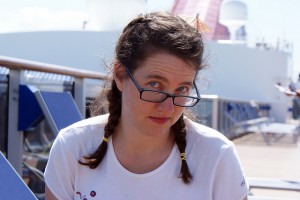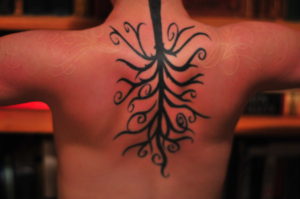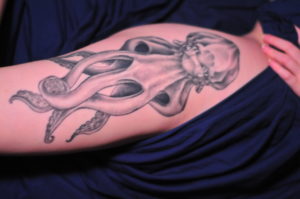 One of the things that is sometimes debated within various pockets of the literary community is the question of whether writing, (or presumably, by extension, any art) can be taught. Though many authors currently practice workshopping in some form, though a good number of us have availed ourselves of night classes, MFAs, opportunities like Viable Paradise or Alpha, and certificate programs like the one I teach at, at UCLA, there are also those who believe teaching writing creates cookie-cutter work.
One of the things that is sometimes debated within various pockets of the literary community is the question of whether writing, (or presumably, by extension, any art) can be taught. Though many authors currently practice workshopping in some form, though a good number of us have availed ourselves of night classes, MFAs, opportunities like Viable Paradise or Alpha, and certificate programs like the one I teach at, at UCLA, there are also those who believe teaching writing creates cookie-cutter work.
There are definitely writers who are ill-suited to workshops, and who’ll generally do better if they bash along on their own. But like all good kernels of thought, it’s possible to get dogmatic about this down with teaching proposition, to argue that a workshop or a class will inevitably ruin new talent by crushing their creativity into some kind of rigid publishing mold.
Naturally, I disagree. (As a general principle, I disagree with anything that presumes that one size fits–or fails–all.)
Now, of course, I would take issue with this, wouldn’t I? I went to Clarion West, after all, and my wife Kelly Robson attended Taos Toolbox. And I do teach, a lot, not only at the UCLA Extension Writers’ Program but in person at UTSC. My bread is entirely covered in student butter. (And I think Kelly’s many award nominations since she began to sell short fiction constitute a powerful argument, in their own right, that workshops can be a force for good!)
Do I think writing can be taught? Obviously. Do I think everything about writing can be taught?
No Way!
With the arts, you’re not a physics professor laying out a formula, some cut-and-dried procedure for which there is one satisfactory answer.* You’re not showing someone how to paint the perfect yellow line down the middle of a strip of road, or fly an airplane without making it go kersplat, or performing open heart surgery. The arts are more fungible. For every so-called rule, there’s at least one fantastic book or story that makes said rule a hilarious joke, a baffled wide-eyed “But!” with cream pie dripping down their face.
 So what is teaching writing like?
So what is teaching writing like?
One of my favorite analogies for the teaching of writing is that it’s a bit like taking a bunch of people to a junkyard, a vast expanse of crushed metal and random parts, oil and cogs and wheels, looming in creaky, ominous, teetering piles.
In a junkyard, at first glance, much of what you see is pretty familiar: busted windshields, steering wheels, coveralls, crowbars, and the smell of paint. Things may be mixed and jumbled, but a gas tank’s a gas tank. Or is that… an oil pan?
Teaching writing is like taking students out to this stretch of familiar parts, and saying: “Okay, you all know what a car is. Now build one.”
They go off. They work at it. Every now and then someone may bring me back a door, or part of an engine, and ask where they should put it. If they do, I’m only to happy to suggest moving a windshield wiper or adding a muffler. But essentially once the task is set, each writer is off, isolated, in their own corner of the wrecking yard, fusing things together into stories, clanking away and hoping it works.
Then, finally, we get to the point where everyone’s made something and the workshop can begin.
Almost all of us have been in more motor vehicles than we could possibly count. How would you even guesstimate? Cars are ubiquitous, less familiar than your skin, but not by that much. You’ve been strapped in baby seats. Drunk and headed home in smelly taxicabs. Alone with a podcast on your nightly two-hour commute. You’ve been on road trips in rentals, trapped on tour buses, and on tenterhooks, possibly, at your driver’s exam.
How many of us could assemble a car out of parts?
In this analogy, the first thing I ask when I see the cobbled-together creations of my students is a pretty simple question: “Does it run?”
If a story doesn’t go, if it can’t carry a reader from some point A to another point B, the author’s generally got to go back to the scrapheap for more or different pieces.
This is an important element of how I think about fiction in all my roles, as a reader, a teacher, an editor, and especially as a writer. I want to create things that are exciting, fuel-efficient, and stunningly beautiful. But none of that matters until the story can move someone. If it can’t, it might as well be a hunk of metal up on blocks in someone’s yard. No matter how great the paintjob, it’s of limited use.
If a story runs–even if it can only cough its way like an ill-used jalopy, to the corner of Flash Fiction Avenue and Finished Street–then I as a coach and the whole workshop group gets to move onto making it run better.
And when it runs pretty well? Then you can really drill into the aesthetics: “Any chance you’d care to make it more attractive and comfortable for the passengers?”
(One of the things that is fun about this particular analogy is that process of translating workshop critique into car talk.)
- “Right now the seats have a funny smell and the ride is really bumpy.”
- “I know POV lives under the hood, but just because you can’t usually see it doesn’t mean you don’t need one.”
- “After the adultery scene, it just kinda runs out of gas.”
Stories and written language surround us, just as cars do. They travel, as cars do. And what the car metaphor gives me is an ability to talk about the building process—to teach via metaphor. You can talk about getting a vehicle up to speed, about skidding out of a turn, about the flashy exterior of a pretty sports car. Oddly, this can sometimes make more sense than “Show, don’t tell.”
Now actual cars do have a right answer, when you’re building them. It would be ludicrous to expect mechanics to learn to assemble them from trial and error.
But what about the part you can’t teach?
I’m an expert, on stories. I can see if they run. I can say if the tires look good and the propeller on top is, probably, a bit too much. But because each writer makes their own story from the ground up, every time, out of a glorious randomosity of bits of wrecked dream, nuggets of grudge, precious hoarded research, glimmers of genius and cobweb threads of memory, the final path to making any tale roadworthy isn’t ever going to be a case of me giving you the One True Answer. Art is not Newtonian physics, or fixing Chevy Cavaliers. I may think that propeller I mentioned, above, has to go. Meanwhile the author’s gut’s is saying “We just need another one, on the bottom. It needs to be made of uranium.”
Somewhere, within that gap between my “That’s not gonna take a reader anywhere!” And their “The propeller is non-negotiable,” is the stuff that can’t be taught. That’s the point where the author has to slink back into the junkyard, wrench at the ready, in search of the pieces to make it fit.
*I got chaff about this, and deservedly so, in a Forbes article by Chad Orzel, who points out that of course there’s scope in physics for creativity. I was thinking about the rote physics teaching I got in high school, which was very much “Here’s how you calculate the force of acceleration, and here’s thirty problems… go to it!” Much of this was driven by the need to have students who could pass the provincial exams, and there were separate problems with my particular physics instructor. I’m tempted to edit the comment (and I did fix a typo!) but I think I’ll content myself with this clarification, and let the point stand.
About this post: There used to be a link on my now-defunct Livejournal to one of my photographs–a picture of a broken traffic light–along with some musings about the nature of teaching creative writing. I called it “the car metaphor essay,” and linked to it often. It contained some handy ideas, but it was also little more than a sketch of the core concept. This new essay attempts to adds a real engine and some new paint to the thing.







 I dictated the draft of this post last night, into my phone, from a comfy seat on the shores of Lake Ontario. I had to pass a few thousand hockey fans to get here; I had not realized a playoff game was happening tonight, but the crowds were identically dressed, good tempered, and very, very huge.
I dictated the draft of this post last night, into my phone, from a comfy seat on the shores of Lake Ontario. I had to pass a few thousand hockey fans to get here; I had not realized a playoff game was happening tonight, but the crowds were identically dressed, good tempered, and very, very huge.
